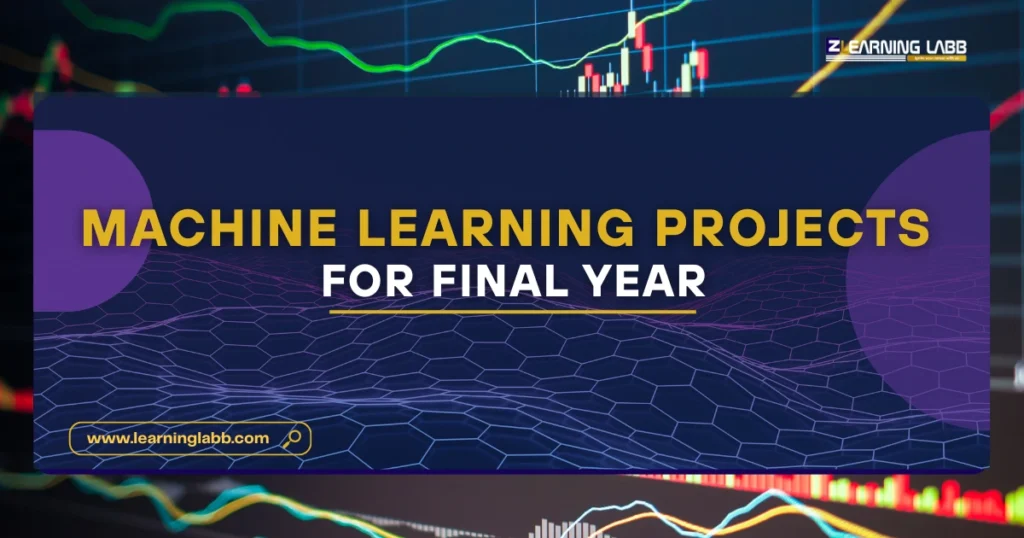Machine Learning Projects For Final Year: Picking the right machine learning projects for final year is often the make-or-break moment for students stepping into the world of AI, data science, and intelligent applications. A well-designed project not only boosts your technical skills but also adds weight to your portfolio.
You may be looking for simple machine learning projects, creative machine learning project ideas, or even advance machine learning projects, this blog will guide you step by step.
We’ll also highlight how institutions like Zenoffi E-Learning Labb, with our P.G. Diploma in Data Science & GEN AI and Advanced Diploma in Data Science, can expose you to projects while teaching you the foundations of machine learning.
Why Machine Learning Projects Matter in Final Year!
Your final year is more than just exams and grades; it’s where you show employers and faculty that you can connect theory with application. Having strong machine learning projects for final year demonstrates three things:
- Hands-on experience: You’ve worked with tools like Python, TensorFlow, or PyTorch.
- Problem-solving mindset: You can identify issues and use ML to solve them.
- Portfolio strength: Recruiters often ask, “What have you built?” rather than “What did you study?”
As our favourite, Andrew Ng once said, “AI is the new electricity.” Projects help you prove that you know how to generate, transmit, and apply that electricity.
Categories of Machine Learning Projects
When searching for machine learning project ideas, it helps to divide them into categories based on complexity. Let’s explore them one by one.
1. Simple Machine Learning Projects
Perfect for ML projects for beginners, these projects focus on datasets that are easy to clean and algorithms that are easy to explain. Examples include:
- House Price Prediction: Using regression to predict housing costs.
- Iris Flower Classification: The classic dataset for beginners.
- Student Performance Prediction: Estimating marks based on study hours.
These simple machine learning projects are great warm-ups before diving into complex builds.

2. Intermediate Level Projects
These require a deeper understanding of preprocessing, feature engineering, and evaluation. Example machine learning topics for project at this stage include:
- Fake News Detection:Text classification using NLP.
- Sentiment Analysis on Tweets: Identifying emotions in social media posts.
- Fraud Detection in Banking: Predicting fraudulent transactions.
Intermediate projects give you the edge by combining algorithms with business problems.
3. Advance Machine Learning Projects
For those aiming at research or a standout portfolio, advance machine learning projects make all the difference. Some options are:
- Autonomous Driving Models: Object detection and lane recognition.
- Medical Image Analysis: Detecting tumors in MRI scans.
- Recommendation System Machine Learning Project: Designing collaborative and content-based systems like Netflix or Amazon.
These projects show your mastery of end-to-end pipelines, from data to deployment.
End to End Machine Learning Project – What Does It Mean?
Many students get stuck at the halfway point of their projects. An end-to-end machine learning project means you cover everything:
- Problem Definition: For example, predicting customer churn.
- Data Collection: Pulling data from Kaggle, APIs, or open datasets.
- Data Cleaning & Preprocessing: Handling null values, normalising, and feature scaling.
- Model Building: Training with algorithms like logistic regression, random forests, or neural networks.
- Evaluation: Accuracy, precision, recall, F1-score.
- Deployment: Using Flask, Streamlit, or FastAPI to make your project usable by others.
- Documentation: Writing README files and presenting results.
A recruiter loves hearing, “This is my end-to-end machine learning project where I built, tested, and deployed a recommendation engine using Python and Flask.”
Machine Learning Projects Using Python
Python is the backbone of modern ML. When you think of machine learning projects using Python, you think of tools like:
- Scikit-learn: Best for classification, regression, clustering.
- TensorFlow & PyTorch: For deep learning and complex architectures.
- Pandas & NumPy: For data preprocessing and manipulation.
Example projects include:
- Predicting flight delays using regression.
- Designing chatbots using NLP and transformers.
- Creating a handwriting recognition app using CNNs.
The good thing? Almost all open-source projects on machine learning use Python, so you’ll have community support and datasets to practice with.
Innovative Ideas for Machine Learning Projects
If you’re looking for uniqueness, here are some innovative ideas for machine learning projects:
- Smart Agriculture System: Predicting crop yield with weather and soil data.
- Disease Prediction from Symptoms: A classifier that suggests possible diseases.
- Energy Consumption Forecasting: For smart grids and households.
- Voice-Enabled Recommendation System Machine Learning Project: Combining NLP and recommendation algorithms.
Projects like these don’t just tick academic boxes, they solve challenges.

Machine Learning Projects For Final Year with Source Code
Here are a few machine learning projects for final year with clear problem briefs and complete, runnable source code (Python). Each one is end-to-end and suitable for a portfolio or viva. You can copy any script into a file and run it in a clean virtual environment.
1) Iris Species Classifier (with Flask API)
What it does: Classifies Iris flowers into Setosa, Versicolor, Virginica.
Why it’s good: Classic, quick to explain, and shows an end-to-end cycle (training + serving).
Dataset: sklearn.datasets.load_iris()
Skills: Pipelines, model persistence, REST API.
How to run
pip install scikit-learn flask joblib
python iris_train_and_api.py
# In another terminal:
curl -X POST http://127.0.0.1:5000/predict -H "Content-Type: application/json" \
-d '{"sepal_length":5.1,"sepal_width":3.5,"petal_length":1.4,"petal_width":0.2}'Source Code — iris_train_and_api.py
# iris_train_and_api.py
from flask import Flask, request, jsonify
from sklearn.datasets import load_iris
from sklearn.model_selection import train_test_split
from sklearn.preprocessing import StandardScaler
from sklearn.pipeline import Pipeline
from sklearn.linear_model import LogisticRegression
from sklearn.metrics import classification_report, accuracy_score
import joblib
import os
MODEL_PATH = "iris_model.joblib"
def train_and_save_model():
data = load_iris(as_frame=True)
X, y = data.data, data.target
X_train, X_test, y_train, y_test = train_test_split(
X, y, test_size=0.2, random_state=42, stratify=y
)
pipe = Pipeline([
("scaler", StandardScaler()),
("clf", LogisticRegression(max_iter=1000))
])
pipe.fit(X_train, y_train)
y_pred = pipe.predict(X_test)
print("Accuracy:", accuracy_score(y_test, y_pred))
print(classification_report(y_test, y_pred, target_names=data.target_names))
joblib.dump({"model": pipe, "target_names": data.target_names}, MODEL_PATH)
print(f"Saved model to {MODEL_PATH}")
def load_model():
return joblib.load(MODEL_PATH)
app = Flask(__name__)
@app.route("/predict", methods=["POST"])
def predict():
payload = request.get_json(force=True)
expected = ["sepal_length", "sepal_width", "petal_length", "petal_width"]
try:
features = [[payload[k] for k in expected]]
except KeyError as e:
return jsonify({"error": f"Missing key: {e}"}), 400
bundle = load_model()
pred = bundle["model"].predict(features)[0]
label = bundle["target_names"][pred]
return jsonify({"prediction": int(pred), "label": label})
if __name__ == "__main__":
if not os.path.exists(MODEL_PATH):
train_and_save_model()
app.run(debug=True)2) California House Price Prediction (Regression)
What it does: Predicts median house value from census-block features.
Why it’s good: Realistic regression with feature engineering and evaluation.
Dataset: sklearn.datasets.fetch_california_housing()
Skills: Pipelines, column transforms, regression metrics, model saving.
How to run
pip install scikit-learn joblib
python california_housing_regression.pySource Code — california_housing_regression.py
# california_housing_regression.py
from sklearn.datasets import fetch_california_housing
from sklearn.model_selection import train_test_split
from sklearn.compose import ColumnTransformer
from sklearn.preprocessing import StandardScaler, PolynomialFeatures
from sklearn.pipeline import Pipeline
from sklearn.metrics import mean_absolute_error, mean_squared_error, r2_score
from sklearn.ensemble import RandomForestRegressor
import numpy as np
import joblib
def main():
data = fetch_california_housing(as_frame=True)
X, y = data.data, data.target # target in 100k USD
num_cols = X.columns.tolist()
preproc = ColumnTransformer([
("num", Pipeline([
("scaler", StandardScaler())
]), num_cols)
])
model = Pipeline([
("pre", preproc),
("rf", RandomForestRegressor(
n_estimators=300, max_depth=None, random_state=42, n_jobs=-1
))
])
X_tr, X_te, y_tr, y_te = train_test_split(X, y, test_size=0.2, random_state=42)
model.fit(X_tr, y_tr)
preds = model.predict(X_te)
mae = mean_absolute_error(y_te, preds)
rmse = mean_squared_error(y_te, preds, squared=False)
r2 = r2_score(y_te, preds)
print(f"MAE: {mae:.3f}, RMSE: {rmse:.3f}, R2: {r2:.3f}")
joblib.dump(model, "california_rf_model.joblib")
print("Saved model to california_rf_model.joblib")
if __name__ == "__main__":
main()3) IMDB Movie Review Sentiment (Deep Learning, Keras)
What it does: Classifies IMDB reviews as positive or negative using an LSTM model.
Why it’s good: Demonstrates NLP preprocessing, embeddings, and deep learning training.
Dataset: keras.datasets.imdb (auto-download)
Skills: Tokenisation, padding, embeddings, LSTM, training curves.
How to run
pip install tensorflow==2.* # or keras>=3
python imdb_lstm_sentiment.pySource Code — imdb_lstm_sentiment.py
# imdb_lstm_sentiment.py
import tensorflow as tf
from tensorflow import keras
from tensorflow.keras import layers
import numpy as np
MAX_WORDS = 20000
MAX_LEN = 200
EMBED_DIM = 64
def load_data():
(x_train, y_train), (x_test, y_test) = keras.datasets.imdb.load_data(num_words=MAX_WORDS)
x_train = keras.preprocessing.sequence.pad_sequences(x_train, maxlen=MAX_LEN)
x_test = keras.preprocessing.sequence.pad_sequences(x_test, maxlen=MAX_LEN)
return (x_train, y_train), (x_test, y_test)
def build_model():
inputs = keras.Input(shape=(MAX_LEN,))
x = layers.Embedding(MAX_WORDS, EMBED_DIM, input_length=MAX_LEN)(inputs)
x = layers.Bidirectional(layers.LSTM(64, return_sequences=True))(x)
x = layers.GlobalMaxPool1D()(x)
x = layers.Dense(64, activation="relu")(x)
x = layers.Dropout(0.3)(x)
outputs = layers.Dense(1, activation="sigmoid")(x)
model = keras.Model(inputs, outputs)
model.compile(optimizer="adam", loss="binary_crossentropy", metrics=["accuracy"])
return model
def main():
(x_train, y_train), (x_test, y_test) = load_data()
model = build_model()
model.summary()
history = model.fit(
x_train, y_train,
validation_split=0.2,
epochs=3, batch_size=128
)
loss, acc = model.evaluate(x_test, y_test, verbose=0)
print(f"Test Accuracy: {acc:.4f}")
model.save("imdb_lstm_model.h5")
print("Saved model to imdb_lstm_model.h5")
if __name__ == "__main__":
main()Machine Learning Project Titles
Sometimes, students struggle with naming their projects. Here are sample machine learning project titles you can use:
- “End-to-End Credit Card Fraud Detection using Random Forests”
- “AI-Based Personalized News Recommendation System”
- “Predicting Student Dropout Using Machine Learning”
- “Image Classification of Fruits Using CNN and Python”
- “Real-Time Sentiment Analysis of Twitter Feeds”
The trick is to keep your machine learning based projects specific, relevant, and outcome-driven.

Open-Source Projects on Machine Learning
Want to explore beyond your classroom? Try contributing to open-source projects on machine learning. GitHub, Kaggle, and Hugging Face host dozens of projects where you can learn real-world coding standards.
Examples include:
- Hugging Face Transformers: NLP models and tools.
- Scikit-learn GitHub: Contribution-friendly ML library.
- PyCaret: Low-code machine learning.
By contributing, you not only learn but also network with global developers.
How to Select the Right Project?
When choosing among hundreds of machine learning projects for students, ask yourself:
- Do I understand the dataset well?
- Can I explain my project to a non-technical audience?
- Will it strengthen my CV for placements?
The best advice is: “Don’t pick a project because it sounds fancy. Pick one that you can actually finish.”
Linking Projects with Career Growth
Here’s the real question, is data science a good career? The answer is yes, but only if you pair theory with hands-on projects.
That’s why many institutions are ranked among the best data science courses in India. If you’re in Bangalore, you’ll find some of the top data science courses in Bangalore offering mentorship and projects.
For instance, Zenoffi E-Learning Labb gives you structured training with best data science courses while letting you build ML applications. This is where your machine learning projects for final year align with career goals.
On A Note…
So, there you go, a full-on guide to ace your machine learning projects for final year. From simple machine learning projects to advance machine learning projects, from Python scripts to recommendation system machine learning projects, you now have ideas, workflows, and even project titles to get started.
Remember, projects are not about code alone; they’re about solving real problems.
And if you’re looking for structured mentorship, don’t forget about programs like ISO-certified Zenoffi E-leaning Labb’s P.G. Diploma in Data Science & GEN AI (12 to 15 Months) or Advanced Diploma in Data Science (6 to 8 Months). Our courses are among the best data science courses, especially if you’re searching for data science courses in Bangalore or even the best data science courses in India!
So, what’s your next step? Are you ready to choose your project title and build an end-to-end machine learning project that speaks volumes in interviews? Contact us to know more.
FAQs
1. What are the easiest machine learning projects for final year?
Simple ones like house price prediction, iris dataset classification, and spam detection are easiest.
2. How do I make my final year project innovative?
Mix domains, try machine learning based projects in healthcare, agriculture, or energy.
3. Can I use Python for all ML projects?
Yes, most machine learning projects using Python cover everything from preprocessing to deployment.
4. How many projects should I include in my CV?
At least 2-3 well-explained end to end machine learning projects are enough.
5. Where can I find datasets?
Kaggle, UCI ML Repository, and GitHub offer free datasets for open source projects on machine learning.





